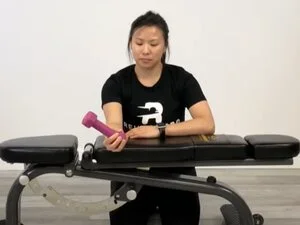Flexor Carpi Radialis Muscle
What is flexor carpi radialis?
The Flexor carpi radialis muscle is a long, slender muscle located in the forearm. It has a fusiform shape and runs from the medial epicondyle of the humerus (upper arm bone) and the common flexor tendon to the base of the second and third metacarpal bones in hand.
The muscle belly of the Flexor carpi radialis is located in the middle of the forearm and is easily palpable. It is bound by a fascia on all sides, which separates it from the surrounding muscles and structures.
The muscle is supplied by the median nerve, which runs alongside it in the forearm. The blood supply to the muscle comes from the radial artery, which runs deep into the muscle belly.
The primary function of the Flexor carpi radialis muscle is to flex the wrist joint, but it also assists in radial deviation of the wrist and contributes to the stability of the wrist joint during gripping and grasping activities.
The entire compartment is also referred to as the flexor compartment of the forearm because all of these muscles are responsible for flexing the hand on the wrist. Apart from wrist flexion, each of these muscles has its distinct function, and the flexor carpi radialis is responsible for both wrist flexion and abduction
Origin of Flexor carpi radialis muscle
The flexor carpi radialis begins from the average epicondyle of the humerus and cross diagonally downwards to the parallel side of the lower arm.
Insertion
The flexor carpi radialis embeds at the foundations of the second and third metacarpal bones.
Nerve
Nerve The Median nerve (C6-C7) supplies this muscle with its innervation.
Artery
The anterior ulnar recurrent artery or the posterior ulnar recurrent artery provides most of the blood supply to the flexor carpi radialis, which is high up in the forearm.
Relations
The Flexor carpi radialis muscle is superficial to the flexor digitorum superficialis muscle and is located deep within the skin of the forearm. It is lateral to the palmaris longus, proximal medially to the pronator teres, and distal medially to the brachioradialis. The attaching tendinous fibers are located deep within the adductor pollicis muscle’s oblique head in the hand.
Concerning neurovascular structures, the median nerve is encased by the proximal portion of the muscle before it enters the flexor digitorum superficialis muscle. The radial artery runs between the tendons of the flexor carpi radialis and brachioradialis muscles, marking a common location for its palpation to measure a person’s radial pulse just proximally to the wrist.
Function of Flexor carpi radialis muscle
The flexor carpi radialis can produce the combined motion of wrist flexion and abduction (radial deviation) because of its oblique course, which pulls the hand proximally and laterally. It works in conjunction with the palmaris longus and flexor carpi ulnaris to produce a balanced flexion of the hand or flexion without abduction. However, when combined with the extensor carpi radialis longus and brevis, it results in a balanced hand abduction as a result of their opposing forces.
As it obliquely crosses the forearm, the muscle contributes less to pronation. It is also active when the digits are extended, preventing unwanted hand extension.
Clinical Relevance
Ruptures of the wrist’s flexor tendon are uncommon. Rheumatoid patients, Tenosynovitis patients who receive cortisone injections, and trauma patients may experience FCR tendon rupture. Scaphotrapezial arthritis can also cause attritional FCR tendon ruptures.
A common location for taking the radial pulse is between the tendons of the brachioradialis and flexor carpi radialis, where the radial artery is located. One of the places to record the patient’s pulse is palpation of the radial artery immediately lateral to the tendon of the flexor carpi radial muscle and proximal to the wrist crease.
Flexor carpi radialis stretching
When the hand is fully extended and the ulnar deviated at the wrist joint, the flexor carpi radialis (a member of the wrist flexor group) is stretched.

Flexor carpi radialis strengthening
Banded wrist curl
The wrist flexor muscle can be strengthened with this exercise. To begin, grip a loop band with your wrist hanging off your knee and your palms facing upward by placing the back of your forearm on your thigh. The forefoot holds the other end of the loop band in place. Twist your wrist by flexing it upwards and expanding it to slowly bring it closer to the floor. Recount as required.

Dowel radial deviation
Using a broomstick or dowel, this wrist-strengthening exercise challenges the forearm muscles. Begin sitting down and hold onto one end of a broomstick or dowel. Start in the thumbs-up position with your thigh supporting the forearm. Lift the dowel by bringing your thumb in close to your forearm as you go. To complete the repetition, slowly lower the dowel. The closer your grip is to the stick’s center, the easier this exercise gets.
Radial deviations
This is an exercise for strengthening the wrist. Place your forearm on a firm surface to support it. Slowly lower a light dumbbell by letting it fall away from your body and toward the floor while holding it at one end with your thumbs up. To finish a repetition, raise the weight back up.

Eccentric wrist curl
The wrist flexor muscle can be strengthened with this exercise. Begin by relaxing the back of your forearm on a sturdy bench, chair, or table while hanging your wrist off the table. Flex your wrist upward while you hold weight and curl it. Bring down the weight gradually towards the floor at a rhythm of five seconds by expanding the wrist. You can help the other hand lift the weight with your free hand. Recount as required.

Eccentric wrist and finger curl
The flexors of the fingers and wrists can be strengthened through this exercise. Begin by resting the back of your forearm on a sturdy bench, chair, or table while hanging your wrist outside of the table. Flex your wrist upward while you hold weight and curl it. Bring down the weight gradually towards the floor at a rhythm of five seconds by expanding the wrist. Allow the load to descend into a snare grip position with your fingers. You can help the other hand lift the weight with your free hand. Recount as required.
Barbell wrist flexor roller
This activity requires a strong band, a racked barbell, and a kettlebell. Wrap one end of the strength band around the cuff of a barbell at shoulder height to begin. To keep the kettlebell in place, feed the other end of the band through the loop on the handle and around the bulb. Standing behind the barbell cuff, maintain it with your palms facing down. To flex your wrists and lift the portable weight off the ground, turn the hand weight sleeve away from you. After the kettlebell reaches its maximum height, slightly loosen your grip to allow it to descend toward the floor. Pay close concentration to where your feet are placed during this phase. Alternately, you could slowly lower the weight by rolling the barbell cuff forward with your wrists.

FAQ
Why is it hurting in my flexor carpi radialis?
The FCR tendon can become compressed or pinched as a result of overuse, which can cause swelling within that sheath. This causes tenderness and pain, usually about an inch above the wrist. Gripping and lifting with the palm up, which both stress the tendon, frequently exacerbate this pain.
Which exercises support the flexor carpi radialis?
With your palm facing up, extend your arm in front of you. Bend your wrist and point your hand toward the ground. Continue bending your wrist with the other hand until you feel light to moderate stretch in your forearm. Hold for somewhere around fifteen to thirty seconds.
How is the flexor carpi radialis used daily?
Wrist flexion is one of the flexor carpi radialis’s actions. Outspread deviation of the wrist. Innervation of the middle nerve. Uses every day: pulling the rope toward you.
What’s the significance of the flexor carpi radialis?
The primary function of FCR is to assist in the abduction of the hand and wrist and provide flexion of the wrist. It has been hypothesized that the flexor carpi radialis (FCR) muscle acts as a dynamic scaphoid stabilizer.
How do I use my flexor carpi radialis to stretch?
Exercises for the flexor carpi radialis Refuse to move your hand in the direction of your thumb. The hand shouldn’t move. This is a wrist, forearm, and elbow strengthening activity. For each side, complete 15 repetitions while holding the resistance for five seconds.








4 Comments